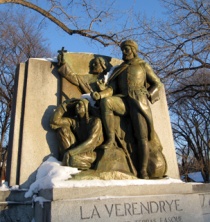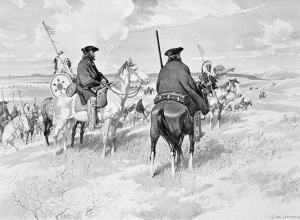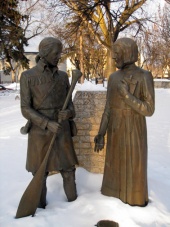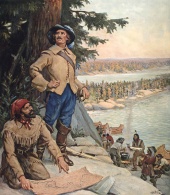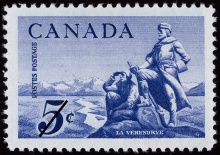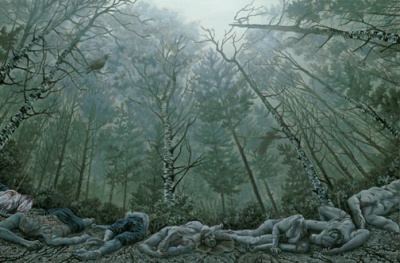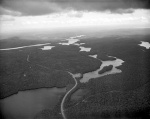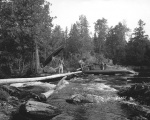La Vérendrye: Archetypal Ideal of the Voyageur
par Combet, Denis
La Vérendrye is one of the key explorers who left his mark on the history of New France. He remains one of the great emblematic figures of Western Canada, largely due to the fact that he was the first voyageur to reach the region of present-day Winnipeg. In Manitoba, his memory is especially honoured and celebrated in commemorative festivities, cultural events and the arts. These celebrations highlight the fact that the French have been present on the Prairies since the days of the Discoverers. In the eyes of many, La Vérendrye epitomizes the archetypal voyageur. He is a symbol of courage and the spirit of adventure, qualities deeply rooted in the mentality of the French, Métis and English voyageurs, who gradually settled this part of North America.
Article disponible en français : La Vérendrye, ou l'archétype du voyageur idéal
La Vérendrye from Past to Present
A Frenchman Who Made His Name in Western Canada
Place names of French origin, such as Fort Rouge, Portage la Prairie and Dauphin, serve to remind us that the first Europeans to reach Lake Winnipeg region between 1735 and 1738 were French from New France, under the command of Pierre Gaultier de Varennes de La Vérendrye. Given that he was, officially speaking, the first French person to set foot in the Winnipeg region, La Vérendrye became a symbol of the lengthy French presence in Western Canada, particularly in Manitoba. This is why the discoverer holds a central place in the collective memory of Franco-Manitobans.
La Vérendrye is a figure linked to a legendary past of origins, i.e., the early trials and tribulations marking the establishment of French civilisation on the Canadian Prairies. This voyageur from Trois-Rivières, Quebec, has remained a major figure in Western French‑Canadian history, particularly for Franco-Manitobans, for whom he personifies all facets of the fighting spirit. The moral qualities of the explorer-a spirit of adventure, courage, tenacity and resistance- were also found in the various groups who were driven to populate this region of Canada, most notably the French who had to fiercely fight for their linguistic rights until Georges Forest made his demands on their behalf in 1971 (NOTE 1) . La Vérendrye is part of the lineage of important French figures in Manitoban history, along with Louis Riel and Bishop Alexandre Antonin Taché, among others. His heroic character and bold initiatives stand out for all to see.
The Métis and English-speaking populations of the Prairies also honour La Vérendrye's memory. For example, in Winnipeg, in October of 2001, the CBC received the Pierre Berton Award for its television program Le Canada: une histoire populaire/Canada: A People's History. Another landmark achievement was also highlighted at this event: the 80th anniversary of the Winnipeg Foundation, one of Canada's largest foundations and an organization that funded the publication of a bilingual edition of de La Vérendrye's journal, which had been launched that very day. This symbolic recognition by an English organization of a French language cultural event central to the history of Winnipeg and Manitoba, even the entire Prairies, is very significant indeed.
La Vérendrye: Archetypal Ideal of a Voyageur
La Vérendrye is alive and well in the shared memories of a variety of cultures and communities-French, English, Métis and Native alike-in both Canada and the United States. He is the archetypal ideal of a voyageur who covered large distances, discovered new waterways and deftly ran a fur trade operation under difficult conditions. Everywhere in Canada, his name has been given to schools, business and government associations, private clubs, golf courses, and streets, as well as to the immense wildlife sanctuary in the Abitibi-Témiscamingue and Outaouais regions of Quebec. A number of canoe-camping organizations named after the explorer also offer their members an experience similar to La Vérendrye's by travelling to the places he explored.
La Vérendrye and the Legend of the Western Sea (1730-1760)
A Difficult Undertaking
Though La Vérendrye is seen as the ideal voyageur, we should not forget the problems associated with any exploration initiative, which, three centuries ago, was basically tempting fate. The French of New France staked their claim to Western Canada by establishing a network of fur trading posts, masterfully set up by La Vérendrye and his sons, and then, expanded by their successors, from 1731 to 1760. The goal of the expedition carried out by the La Vérendrye clan in the region of Lake Winnipeg was not only to seek the Northwest Passage to the Western Sea, but also to establish a far-reaching business. To do so, new alliances had to be forged with the region's Natives and the new partnerships had to be able to successfully compete with the English Hudson's Bay Company.
Alhough La Vérendrye's initiatives were well received in Quebec and France from 1731 to 1735, the years following this period were marked by a series of setbacks and mishaps that undermined the efforts of the officer-merchant and ended up discrediting him in the eyes of the French minister of the navy and colonies, Jean-Frédéric Phélypaux de Maurepas. Nevertheless, the Governor of New France, Charles de La Boische de Beauharnois, persistently defended his protégé, while the navy minister did everything he could to expel the La Vérendrye family from the West. The family was also the target of jealous, even malicious gossip, coming from the colony members themselves.
La Vérendrye Stands Alone against the Rest (1736-1747)
In the end, it was the great distance separating Montreal from Lake Winnipeg, which was the logistical problem associated with the transportation of trade goods that increased their cost exponentially and created disputes with merchants and associates that ruined La Vérendrye. He also had a difficult time recovering from two tragedies that shook up his life in 1736. His nephew, Christophe Dufrost de La Jemerais, a remarkable voyageur who had established Fort Maurepas at the mouth of the Winnipeg River in 1735, died of exhaustion at Roseau River the following year. In June 1736, Jean-Baptiste La Vérendrye (the discoverer's eldest son), the Jesuit priest Jean-Pierre Aulneau de la Touche, along with 19 voyageurs accompanying them, were massacred by a Sioux war party in Lake of the Woods. The ancestral war fought by the Cree and the Assiniboines against the Sioux put an end to a profitable treaty, as well as to a peace plan that the explorer had been mandated to negotiate between these nations.
Pierre de La Vérendrye doggedly pursued his discovery endeavour, overcoming the difficulties he encountered and the incessant criticisms of which he was a victim. In 1738, Fort La Reine was built in present-day Manitoba, which was intended to serve as the starting point for his encounter with Mandan Natives in current-day North Dakota, among whom he lived until the spring of 1739. However, a expedition towards the Rockies in 1742 - 1743, carried out by two of his remaining sons, Louis-Joseph and François, put an end to speculations about the existence of an easily accessible, land-locked sea or passage that opened onto the Pacific and Asia. And so, Pierre de la Vérendrye was excluded once and for all from the trading posts in the West in 1747. The voyageur then returned to live in Quebec City, where Governor Beauharnois continued to back him and named him captain of his personal guard. La Vérendrye was also awarded the Saint-Louis Cross by the new navy minister, Antoine-Louis Rouillé, before he died in December of 1749, just as he was preparing to depart once again in search of the Western Sea.
The Fur-trading Tradition and the Birth of the Métis Nation
Above and beyond the successes and failures related to the search for the Western Sea, it is also possible to learn about the lives of New France's seigneur-voyageurs from the La Vérendrye family's experiences. In addition, they also left accounts of their encounters with the Native element. In fact, after the fall of New France, in 1763, a number of voyageurs remained in the West, integrating with the Native peoples and often playing leadership roles in their communities. With the 1779 creation of the North-West Company in Montreal, a even larger number of French Canadians, who were known for their stamina and communication skills, began to mingle with the First Nations because of the rapport that they had developed during travels to the West for trading purposes. Out of the meeting of these two worlds came a new, mixed-race Métis people, who would thereafter play a key role in determining the direction of Canadian history. (This is particularly true of the Catholic Métis community of Red River). The fur trade established between voyageurs and Natives personified a life style whose cultural reality is still alive today, as it can be demonstrated by the success of the Festival du Voyageur, which has been held in St. Boniface since 1970.
Images of La Vérendrye and a recollection
The St. Boniface Historical Society (SBHS) and the Memory of the La Vérendryes
As soon as it was founded in 1902, the St. Boniface Historical Society (SBHS), whose main purpose is to"conserve and promote heritage" (NOTE 2), decided to commemorate the La Vérendryes' endeavours on the Canadian plains. Between 1902 and 1908, four expeditions were organized under the direction of the SBHS, with the purpose of setting out to discover Fort St. Charles and the vestiges of the mutilated bodies of Jean-Baptiste de La Vérendrye, Father Aulneau and the voyageurs who accompanied them. Their skeletons, uncovered on August 7th, 1908, on the south bank of Massacre Island on Lake of the Woods, along with certain objects that had belonged to them, were kept at St. Boniface College until a fire destroyed the building in 1922.
A number of historical studies have been undertaken by members of the SBHS over the years. Father Morice, Judge Prud'homme, and the journalist Donatien Frémont, along with Father Antoine Champagne in the 1960s, all wrote important works testifying to the voyageur's continuing relevance for their contemporary societies. Finally, the new St. Boniface Heritage Centre, inaugurated in 1998, has preserved La Vérendrye's contracts and assembled relevant historical sources for researchers.
Commemorative Images of La Vérendrye: Architecture, Paintings and Literature
In 1936, a commemorative plaque designed to honour the death of Dufrost de La Jemerais was unveiled in Lettelier, Manitoba. A special memorial for La Vérendrye himself was created and inaugerated in September of 1938, during the bicentennial celebration of his trip to the forks of the Red and Assiniboine rivers. A commemorative monument was unveiled on this occasion, after which a parade and celebration took place in Whittier Park. The Winnipeg Canoe Club also organized a historical re-creation featuring 200 canoes, manned by Natives and voyageurs, paddling down the Red River. In 1976, a commemorative monument honouring Father Aulneau and Jean-Baptiste de La Vérendrye was erected across from the St. Boniface Cathedral. In 2007, the Société du Monument National La Vérendrye Inc. laid the groundwork for the creation of a monument commemorating the explorer's stay in Manitoba.
Over the years, other initiatives have been undertaken, including the re-creation of Fort St. Charles on Lake of the Woods and Fort La Reine in Portage La Prairie, each of which was converted into a museum. Artists produced paintings intended to record this adventure imprint it on the shared memories of Manitobans and French Canadians alike. This is especially the case of the magnificent painting by Pauline Boutal that adorns St. Boniface's Club de La Vérendrye, as well as of the 12 canvases painted in 2001 by Métis artist René Lanthier. They are intended to re-create some of the most important moments of La Vérendrye's expeditions in search of the Northwest Passage to the Western Sea. Proceeds from their sales have been earmarked for a La Vérendrye scholarship to be granted to a history student from the Collège Universitaire de Saint-Boniface. There is also an entire section featuring documents and literature pertaining to the explorer, which includes documents from the National Film Board of Canada, a comic strip entitled La Vérendrye, Explorateur de l'Ouest Canadien (NOTE 3) and a novel, Les Chasseurs de Continents: La Vérendrye et Fils (NOTE 4).
La Vérendrye: from New France to Manitoba (1738-2008)
Although less esteemed and celebrated outside Western Canada, Pierre Gaultier de Varennes de La Vérendrye, this brave scion of New France, is nevertheless far from forgotten. For example, the discoveries he made in Western Canada have been widely recognized by Quebecois and are taught in most of the province's schools. Furthermore, a French historical-re-creation organization from St. Boniface, La Compagnie de La Vérendrye, was invited to participate in Quebec City's 400th anniversary celebrations in 2008, a symbolic gesture intended to commemorate this officer of the Compagnies Franches de la Marine who was the first person to map and describe a region that, since the mid-18th century, has considered itself to be one of the most important strongholds of French North America, given its rich and unique heritage.
Although La Vérendrye symbolizes the ideal voyageur for numerous Canadians, it must be recognized that he is above all an emblematic figure of French Manitoba. The discoverer belongs to an era of legends. His life may not have been as tragic as that of Manitoba's founding father, Louis Riel, but the drama surrounding him, both in space and in time, can be seen as a precursor of the greater battles lying ahead for both Métis and French. In this sense, he incontestably stands out as the founding pillar of a French-Catholic tradition that remains well anchored in Manitoba to this very day.
Denis Combet
Professor of French Literature
Brandon University, Manitoba
Additional DocumentsSome documents require an additional plugin to be consulted
Images
-
 Dévoilement du monume
Dévoilement du monume
nt La Vérendrye... -
 La Vérendrye
La Vérendrye
-
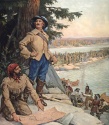 La Verendrye au lake
La Verendrye au lake
of the Woods, v... -
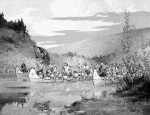 La Vérendrye, Canada'
La Vérendrye, Canada'
s Farthest West...
-
 Le massacre de Jean-B
Le massacre de Jean-B
aptiste de La V... -
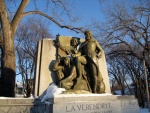 Monument de La Vérend
Monument de La Vérend
rye dans le par... -
 Monument du père Auln
Monument du père Auln
eau et de Jean-... -
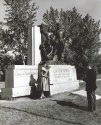 Monument La Vérendrye
Monument La Vérendrye
Catégories
Notes
Note 1: "On the political side, the decision of the Supreme Court of Canada in the case of Georges Forest stipulated in 1979 that the Official Languages Act of 1890 is unconstitutional and re-established Manitoba as a bilingual province," Au Pays de Riel, "La présence française dans l'Ouest: les débuts," Patrimoine canadien, Société historique de Saint-Boniface, 2004, [On line]. [Consulted in French from September 30th, 2007, to January 25th, 2008; original citation translated into English for this text]
Note 2: The Heritage Centre, "Les grandes lignes de l'histoire de la Société historique de Saint-Boniface," [On line]. [Consulted in French from September 30th, 2007, to January 25th, 2008].
Note 3: Robert Freynet, La Vérendrye, explorateur de l'Ouest canadien, Apprentissage Illimité, 2002.
Note 4: Yves Breton, Les chasseurs de continents: La Vérendrye et fils, L'interligne, 1999.
Bibliographie
Allaire, Gratien, « Officiers et marchands: les sociétés de commerce des fourrures, 1715-1760 », Revue d'histoire de l'Amérique française, vol. 40, no 3, 1987, p. 409-428.
Au Pays de Riel, « La présence française dans l'Ouest: les débuts », Patrimoine canadien, Société historique de Saint-Boniface, 2004, http://www.shsb.mb.ca/paysriel/accuei.html [Consulted in French from September 30th, 2007 to January 25th, 2008].
Champagne, Antoine, Les La Vérendrye et le poste de l'Ouest, Québec, Les Presses de l'Université Laval, 1968, p. 591.
Champagne, Antoine, Nouvelles études sur les La Vérendrye et le poste de l'Ouest, Québec, Les Presses de l'Université Laval, 1971, p. 249.
Chartrand, René, Le patrimoine militaire canadien : d'hier à aujourd'hui, Tome I : 1000-1754, Montréal, Art Global, 1993, p. 239.
Combet, Denis, À la recherche de la mer de l'Ouest : mémoires choisis de La Vérendrye, Saint-Boniface, Éditions du Blé, Winnipeg, Great Plains Publications, 2001, 197 p.
Dauphinais, Luc, Histoire de Saint-Boniface, Tome I : À l'ombre des cathédrales, Éditions du Blé, 1991, p. 340.
Dorge, Lionel, Introduction à l'étude des Franco-Manitobain, Essai historique et bibliographique, La Société Historique de Saint-Boniface, 1973, p. 298.
Le Centre du Patrimoine, Les grandes lignes de l'histoire de la Société historique de Saint-Boniface. [En ligne]. [Consulted in French from September 30th, 2007 to January 25th, 2008].
Zoltvany, Yves F., « Gaultier de Varennes et de La Vérendrye, Pierre », Dictionnaire biographique du Canada, vol. III, Sainte-Foy, Québec, Les Presses universitaires Laval, 1974, p. 264-273.

